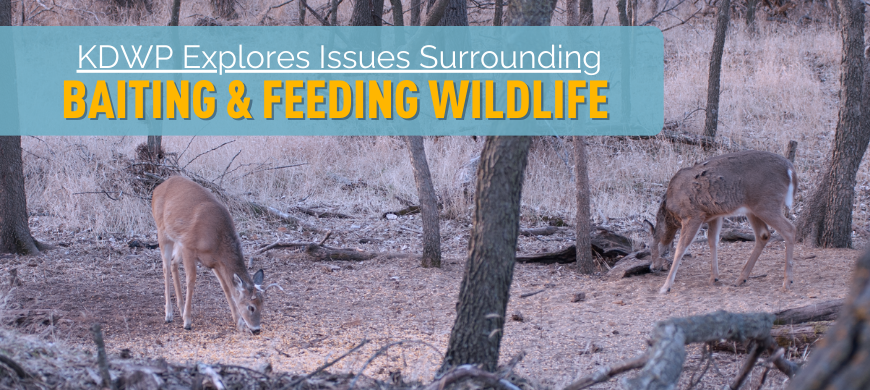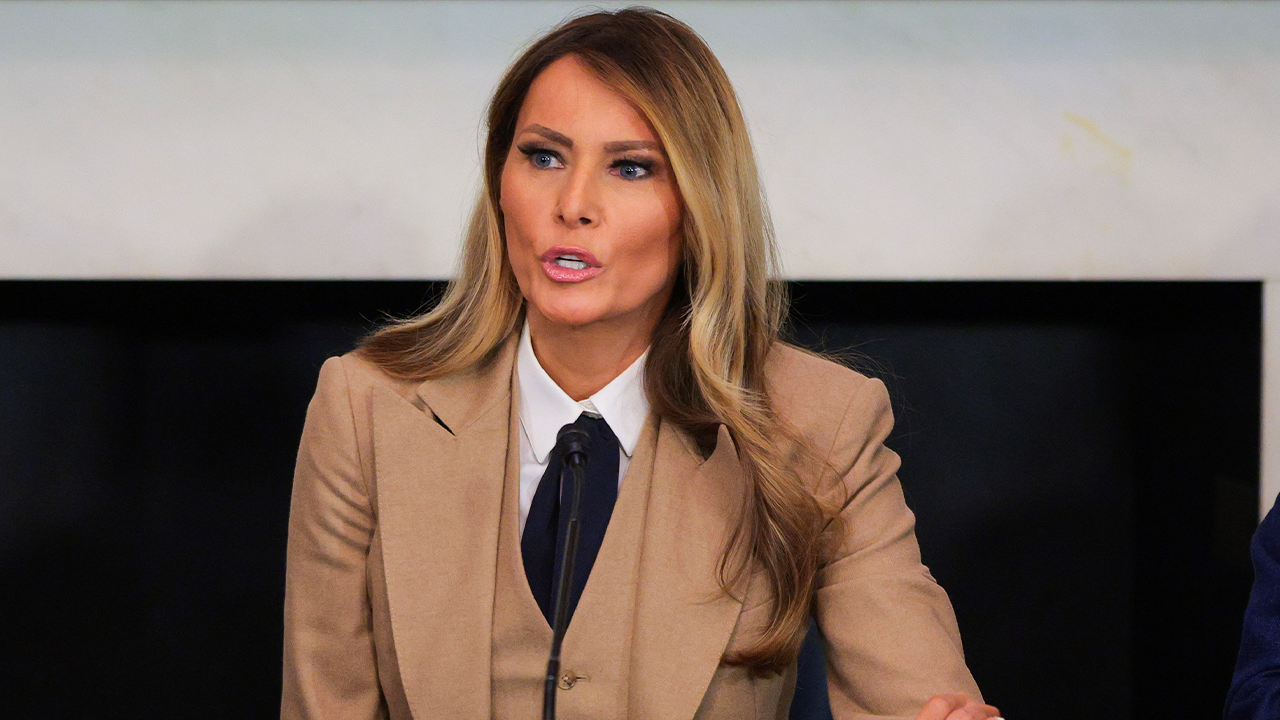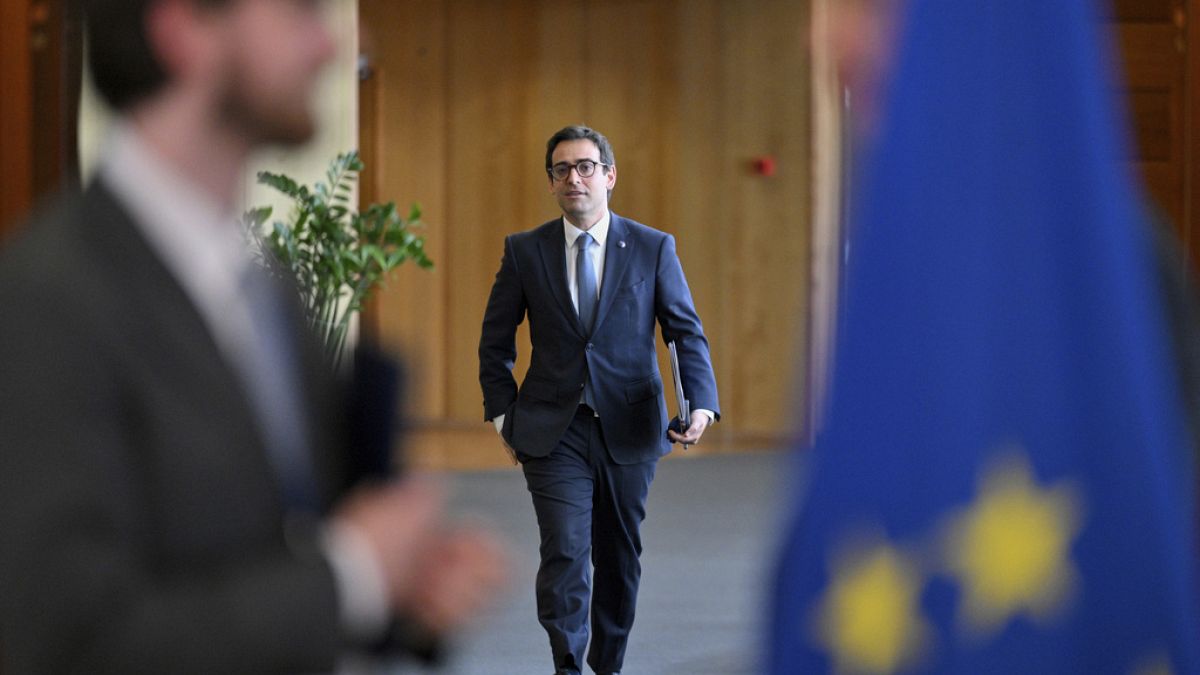Kansas
Kansas Department of Wildlife and Parks to Explore Issues Surrounding Baiting Wildlife

For Immediate Release:
July 3, 2023
Contacts:
Nadia Marji, Chief of Public Affairs
Nadia.marji@ks.gov
Megan Mayhew, Digital Communications Manager
Megan.mayhew@ks.gov
Kansas Department of Wildlife and Parks to Explore Issues Surrounding Baiting Wildlife
- On June 22, 2023, KDWP held a public panel discussion on baiting wildlife with subject matter experts from Kansas, North Dakota, and Oklahoma
- The Department defines baiting wildlife as “The act of intentionally placing food, or nutrient substances, to manipulate the behavior of wildlife species;” This is not to be confused with agricultural food plots or backyard birdfeeders.
- KDWP will host several town hall-style public meetings in the coming months to solicit broader input on these complex issues
- Though staff intend to make baiting wildlife a regular discussion item at future Commission meetings, no official regulation recommendations are planned.
- In Kansas, it is illegal to bait wildlife on public lands, and lands enrolled in the Walk-in Hunting Access program
- Baiting is allowed on private lands in Kansas, which comprise 98 percent of the state
KANSAS CITY, Kan. – Due to growing concerns within the scientific community about increases in transmissible diseases among wildlife, staff and Commissioners with the Kansas Department of Wildlife and Parks have taken the first steps in what will be a multi-year exploration of issues surrounding baiting wildlife – a leading cause of the unnatural congregation of wildlife and subsequent spreading of diseases.
The Department defines baiting as, “The act of intentionally placing food, or nutrient substances, to manipulate the behavior of wildlife species;” This is not to be confused with food plots planted consistent with accepted local and regional agricultural guidelines, which the Department does not oppose.
What’s Being Discussed
Kansas Wildlife and Parks Commissioners hosted a general public panel discussion on June 22, 2023, where subject matter experts from Kansas, North Dakota and Oklahoma shared insights into: The history of baiting in the Midwest; Increased risks of disease transmission; Nutrition and toxins associated with baiting and supplemental feeding; and animal behavior, among other concerns.
Next Steps
The June 22, 2023, panel discussion – which lasted approximately two hours – will serve as a springboard for several town hall-style public meetings set to take place in the coming months, during which time KDWP staff and Commissioners will solicit input from the broader public, including hunters, landowners, members of industry and more.
Though staff intend to make baiting wildlife a regular discussion item at future Commission meetings, no official regulation recommendations are planned.
KDWP will advertise the date and time of all public meetings on ksoutdoors.com. Members of the public can sign up to be notified HERE.
Current Regulation
Commissioners voted on June 22, 2023, to amend a pre-existing regulation (KAR 115-8-23) established in 2012 that prohibited baiting on Department Lands and Waters – the June 22, 2023, amendment added language stating baiting would be prohibited for “all activities” on public lands, not just for hunting (as the regulation was originally written).
Baiting wildlife remains a legal activity on all private lands in Kansas, which comprise nearly 98 percent of lands in the Sunflower State.
To be notified of all future public meetings related to baiting wildlife and more, sign up to receive KDWP news HERE.
###

Kansas
Kansas Football Battling With Two Elite Programs for Defensive Recruit

On Wednesday, highly touted defensive tackle Alister Vallejo announced he would be making his college decision on June 10 between the Kansas Jayhawks, Michigan Wolverines, and Notre Dame Fighting Irish.
A powerful 6-foot-3, 310-pound star, Vallejo is one of the best interior linemen in his graduating year. 247 Sports ranks him the No. 203 overall player and No. 32 defensive lineman in the Class of 2026.
He is an incoming senior at Liberty Hill High School in Texas, where he totaled 51 tackles, seven sacks, and nine tackles for loss last year, according to MaxPreps.
Lance Leipold will have to compete with two of the best football programs in the country in the race to acquire Vallejo.
Perhaps the biggest competition KU faces is Notre Dame, as he is scheduled to take an unofficial visit to the campus next week.
Following that trip, Vallejo will officially visit Kansas starting June 6. He previously met with the coaching staff in Lawrence in March.
The Jayhawks have been involved in Vallejo’s recruitment for quite some time, becoming just the second FBS school to offer him a scholarship this past January.
Some encouraging news is that his visit to Kansas will be his last before his college decision on June 10.
In what has been an incredible 2026 recruiting class for KU, Vallejo would be the latest impressive commitment if Leipold and Co. could land him.
Kansas
Kansas House Democrats kick off statewide tour in Topeka on Thursday

Tariffs prompting Walmart to raise prices in coming weeks
Walmart says they are raising prices soon due to President Donald Trump’s tariffs and trade policy.
- Kansas House Democrats are launching an 11-stop “Fight Back Tour” across the state, including areas where they’ve lost electoral support.
- Democrats acknowledge the challenge of localizing political discourse in a nationalized environment, aiming to shift focus from Trump to state-level issues.
- The tour targets areas with little to no Democratic representation, seeking to counter negative perceptions and rebuild support for 2026.
Kansas House Democrats are kicking off their statewide “Fight Back Tour” at 6 p.m. May 29 at Compass Point, 800 N. Kansas Ave. in Topeka, in an 11-stop tour that mostly focuses on regions Democrats have fallen out of favor electorally.
Every House Democrat will be featured in at least one stop on the tour. In Topeka, three current Topeka Democrats will be involved, as well as two former representatives, House Minority Leader Brandon Woodard and Gov. Laura Kelly.
Rep. Kirk Haskins, D-Topeka, said he’s viewing the tour as a way to hear from voters as much as it is about sharing a message with them.
“I’m going to focus a lot on learning more from the constituents on what we need to be focusing on. That’s my primary goal,” Haskins said.
As the ranking member of the House Committee on Elections, Haskins said he plans to spend some of his speaking time on updates in election law — specifically Senate Bill 4, which repealed a law allowing the acceptance of mailed ballots three days after Election Day.
He also plans to speak about school funding and workforce development.
Rep. Alexis Simmons, D-Topeka, said her message will be about “the complete and total abuse of power that takes place in the state Legislature.”
“We’re forced to vote on bills that we’ve not had a chance to review because the leadership knows that they’re unpopular, quite honestly, and they don’t want to give the public a chance to speak out against them,” Simmons said.
All politics is national
All politics is local, a longtime truism of American campaigning, no longer seems true with politicians increasingly following the lead of the national news cycle.
Grassroots Democratic opposition in the wake of the 2024 election has largely been focused on the Trump administration. The 50501 Protest movement, a loosely affiliated network of sources primarily organizing through online communities, has largely channeled frustrations about the Trump administration rather than on politicians that are closer to home.
Contentious town halls where Republicans were peppered with tough questions by attendees were usually targeted at members of the U.S. Congress and Senate.
The House Democrats in their tour will try to avoid making the tour about President Trump, but acknowledge the subject is unavoidable when discussing politics.
“We really want to talk about the stuff that people may not have heard about in the news that is going to affect them more directly than all the huge headlines that are coming down from Washington,” said Nicole Norvelle, communications director of the House Democrats.
Explaining the process and responsibilities of state, local and federal politics is half the battle, according to Haskins and Simmons. Haskins said when campaigning, he’s often asked about things like potholes, a local issue or about goings-on at the federal level.
Simmons said conversations about Trump can be brought back to the local level.
“A lot of the things taking place right now in our Legislature, we could fight back on if it were not held by a supermajority that is hyper and blindly loyal to President Trump,” Simmons said.
Campaigning outside of Democratic strongholds
Though three stops of the tour are in areas with Democratic representatives in the House, the remaining eight will be held in areas where there is no current representation in the Kansas House.
“This is our effort to go out across the state and talk to Kansans who don’t normally hear from us, so that they know that we’re gearing up for 2026 to win back seats, and that we’re not going to take what happened this last year lying down,” said Nicole Norvelle, communications director of the Kansas House Democrats.
Norvelle said House Democrats are working with county-level parties to select the right speakers for each community.
In Newton, that means selecting representatives Democrats think will resonate with Bethel College students. In Garden City and Dodge City, that means selecting representatives Democrats think will connect with Hispanic populations.
Countering Democratic unpopularity
Polling after the elections shows Democratic voters are pessimistic about their party, with a Associated Press-NORC Center for Public Affairs poll in May showing just one-third of Democrats are optimistic about their party, down from 6 in 10 in July.
“I think the perception of Democrats has just really altered over the years, I think that’s the general consensus, is people have a new idea of what a Democrat is, which is a very elitist image,” Norvelle said.
Norvelle said House Democrats will focus on issues like health care access, affordable housing, supporting public schools and combating tax cuts for the rich to counter the narrative.
“This is a great starting point to really connect with people and say, ‘Hey, this idea you have of Democrats is not correct. A lot of the policies that were created this year by the Republicans are going to hurt you, your family, your business,’” Norvelle said.
Democrats don’t hold a seat in many of the communities they’re visiting, but it’s not unprecedented for some representation in central and west Kansas.
Hutchinson, which the tour will stop at on June 20, elected former Rep. Jason Probst, D-Hutchinson, as recently as 2022. All House representatives from Leavenworth are Republican, but former Sen. Jeff Pittman, D-Leavenworth, was elected in 2020.
“I think showing that we’re not the big, bad scary libs is a good place to start,” Simmons said. “A lot of these places have historically been held by Democrats, and so the more we can define ourselves as fighters for working class Kansans, the more successful we’re going to be.”
Here are the communities House Democrats will appeal to
Following are the towns and dates at which House Democrats will appear in a statewide “Fight Back Tour.” Times for most appearances haven’t been announced yet.
- Topeka, 6 p.m. May 29.
- Wichita: June 5.
- Newton: June 6.
- Hutchinson: June 20.
- Abilene: June 21.
- Garden City: July 18.
- Dodge City: July 19.
- Pittsburg: July 24.
- Hays: Aug. 15.
- Kansas City, Kansas: Aug. 21.
- Leavenworth: Aug. 28.
Kansas
Keeping Michael Massey in Kansas City isn’t helping anyone

Michael Massey is easy to root for. We’ve all seen athletes who are full of themselves, and frankly you want athletes to have a little swagger—it’s a mentally demanding profession where fans can switch from giving you love to sending you death threats.
But some players come across as good guys, and in Massey’s case, that’s true for the folks who work with him. There’s an award given by the Kansas City chapter of the Baseball Writers’ Association of America called the Mike Swanson Good Guy Award, and Massey has won it in back-to-back years.
So when Massey struggled out of the gate this year, fans weren’t particularly phased. In part, this is because Massey was legitimately good at the plate last year. In part, it’s because other players—MJ Melendez, Hunter Renfroe, Cavan Biggio—drew the lion’s share of the ire, and a fanbase can’t get mad about everybody (most of the time).
Now, all three of those other players are no longer with the team. Massey, however, is, though he really shouldn’t be. Per Fangraphs’ version of Wins Above Replacement, there are 17 players this year with 100 or more plate appearances and less than -0.5 WAR. Of this 287-player set, Massey is fourth-worst at -0.9 WAR. The others worse than him? Andrew Vaughn, who the White Sox optioned to Triple-A. The aforementioned Renfroe, who the Royals cut recently. And LaMonte Wade Jr., whose recent track record is enough to keep him on the field for longer.
What has happened to Massey? Well, the answer might be what hasn’t happened to Massey? Just about everything is worse in his hitting portfolio: he’s walking at a career worst level, he’s barreling balls at a career worst level, his average and max exit velocity are at career lows, his hard hit rate is at a career low. It hasn’t been good.
This also does not feel good. To put this into, like, normal people terms, doing this poorly for such a long time is like playing Overwatch or Counter-Strike or League of Legends and getting into a big losing streak. This sucks, and when you’re in the middle of the losing streak, you’re more likely to be grumpy to teammates and see your performance go down, which begets more losing and bad play. Massey probably isn’t a Hanzo main or anything, but that doesn’t matter because we can see how he’s reacting to screwups like this popup on Sunday’s game: he’s mad at himself!
We have reached the point in the season where keeping Massey up in Kansas City isn’t helping anybody. It’s not helping Kansas City, where Massey is now functionally the second-worst hitter in the league and an offensive black hole. It is also not helping Massey, who looks just plain lost out there. If he’s going to get back on track, it is not going to be here in Kansas City, where he is making outs at a huge clip.
Frankly, I don’t think there’s a route forward for Massey to be a productive big leaguer regardless what he does. It all comes down to getting on base, which he does not do. In about 1,200 plate appearances, Massey’s on base percentage is .277. That’s just not going to cut it, especially when you look at his historical exit velocities and barrel rates, which aren’t high enough to yield the power that he needs to produce to overcome such a low OBP.
Who could take Massey’s place? There are two options. One is a like-for-like replacement, with infielder Cam Devanney getting the call. Devanney is a 28-year-old who is in his fourth year in Triple-A, but he’s crushing it this year to the tune of a .301/.382/.618 triple slash. The other option is a lefty-for-lefty callup with Jac Caglianone taking Massey’s spot. Realistically, that’s probably what’s likely to happen—in a few weeks at minimum.
So yeah, it might stink to send Massey down, as he’s been an exemplary teammate and ambassador for the team. But this is a results-based business, and the results have been so poor in such a way that nobody is really benefiting from the reunion right now. I wish it wasn’t the case. I, too, would like Massey to succeed. It’s just not happening.
-

 News1 week ago
News1 week agoMaps: 3.8-Magnitude Earthquake Strikes Southern California
-

 Education1 week ago
Education1 week agoVideo: Columbia University President Is Booed at Commencement Ceremony
-

 Culture1 week ago
Culture1 week agoDo You Know the English Novels That Inspired These Movies and TV Shows?
-

 Politics1 week ago
Politics1 week agoTrump, alongside first lady, to sign bill criminalizing revenge porn and AI deepfakes
-

 Education1 week ago
Education1 week agoHow Usher Writes a Commencement Speech
-

 World1 week ago
World1 week agoDigitisation fronts new Commission strategy to boost EU single market
-

 Politics1 week ago
Politics1 week agoExpert reveals how companies are rebranding 'toxic' DEI policies to skirt Trump-era bans: 'New wrapper'
-

 World1 week ago
World1 week agoEU reaches initial deal to lift economic sanctions on Syria: Reports

















